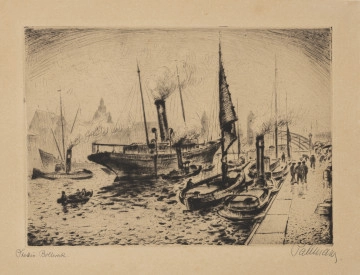
View of the harbour and the Castle Hill
około 1930
National Museum in Szczecin
Part of the collection: Iconography of Szczecin 1900-1945
The industrial and economic development of Szczecin accelerated in the second half of the 19th century. These changes were quickly reflected in art, especially in views of the city. In the following decades, the landscape in the Oder region was changing into a typically worker-industrial one. The process fascinated and inspired many artists, who eagerly drew on industrial motifs to faithfully depict the cityscape. The utilitarian character of iconography was also crucial. Compositions with views of industrial buildings were created for the needs of information and technical publications and vignettes decorating business papers. They also appeared in the advertising materials of industrial plants, increasing their prestige. Enlarged vignettes often took the form of the company’s portrait and showed the current appearance of the plant, decorating the directors' offices. Graphic compositions depicting Szczecin's factories, reproduced in trade and industry publications, are a valuable documentation of the appearance of factories that were rebuilt or no longer exist. They showed their layout, form and size from an elevated viewpoint or from a bird's eye view. Such an illustration decorating a publication of the Berlin publishing house Eckstein's Biographischer Verlag is a print from 1907 by an unknown author, showing a bird's eye view of the complex of buildings of the chemical factory in Szczecin's left-bank district Pomorzany (Pommerensdorf), which from the end of the 19th century was known for its numerous factories, industrial plants and a railway junction conducive to industrialisation. The graphic representation of the low-rise factory buildings is precise. Single chimneys and evenly distributed buildings give the impression of order, and the delicate Oder panorama visible in the background makes the industrial buildings not overwhelming. The nobility of the composition is added by the image of the German goddess Sedina surrounded by dragons in the bottom right corner; she became a symbol of Szczecin at the end of the 19th and the first half of the 20th century thanks to the fountain created by the German sculptor and draughtsman Ludwig Manzel (1858-1936).
Małgorzata Peszko
Author / creator
Dimensions
cały obiekt: height: 32 cm, width: 47 cm
Object type
graphic
Creation time / dating
Creation / finding place
Identification number
Location / status

Dekkert Eugen
około 1930
National Museum in Szczecin

Pallmann, Kurt
1920 — 1935
National Museum in Szczecin

nieznany
1890 — 1910
National Museum in Szczecin
DISCOVER this TOPIC
Museum of King Jan III's Palace at Wilanów
DISCOVER this PATH
Educational path
0/500

We use cookies to make it easier for you to use our website and for statistical purposes. You can manage cookies by changing the settings of your web browser. More information in the Privacy Policy.
We use cookies to make it easier for you to use our website and for statistical purposes. You can manage cookies by changing the settings of your web browser. More information in the Privacy Policy.
Manage cookies:
This type of cookies is necessary for the website to function. You can change your browser settings to block them, but then the website will not work properly.
WYMAGANE
They are used to measure user engagement and generate statistics about the website to better understand how it is used. If you block this type of cookies, we will not be able to collect information about the use of the website and we will not be able to monitor its performance.